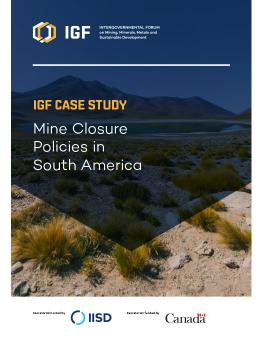
IGF Case Study: Mine Closure Policies in South America
Latin American governments are moving away from relying on mining companies to follow best practices on mine closure toward developing national legislation to ensure compliance. Chile and Peru are leading the way with national mine closure legislation that requires mining operations to provide financial assurance to cover closure liabilities.
Governments in Latin America are transitioning away from relying on mining corporations to follow international best practices and toward developing national legislation surrounding mine closure.
Across the region, there are many countries where legislative expectations around mine closure are established through environmental and social impact assessments (ESIAs) for new mining projects. But this ESIA process has historically failed to protect the state against inheriting the financial liabilities for closing a mine site in the case of a bankruptcy or other events where the company is unwilling or unable to pay for the cost of closure.
In Latin America, to date only Chile and Peru have established comprehensive, national mine closure legislation that requires mining operations to provide financial assurance for closure liabilities. This report examines Chile and Peru’s policies.
You might also be interested in
Women and the Mine of the Future
Uncovering the gender-disaggregated employment profile for large-scale mining, focusing on women and their occupations in 12 countries.
IGF Case Study: Mine Water Management
Following an overview of important components of watershed management, the two case studies show how each jurisdiction has evolved and is making improvements.
Strategic Environmental Assessment for the Mining Sector
Strategic environmental assessments (SEA) are an essential tool for policy-makers working to develop a sector-wide vision for responsible mining.
Financial Benefit-Sharing Issues for Critical Minerals: Challenges and opportunities for producing countries
Exploring nuances in the key features of critical minerals and the new challenges and opportunities they present to fiscal regulation.